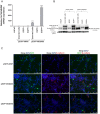Constitutively active androgen receptor variants upregulate expression of mesenchymal markers in prostate cancer cells
- PMID: 23658830
- PMCID: PMC3642121
- DOI: 10.1371/journal.pone.0063466
Constitutively active androgen receptor variants upregulate expression of mesenchymal markers in prostate cancer cells
Abstract
Androgen receptor (AR) signaling pathway remains the foremost target of novel therapeutics for castration-resistant prostate cancer (CRPC). However, the expression of constitutively active AR variants lacking the carboxy-terminal region in CRPC may lead to therapy inefficacy. These AR variants are supposed to support PCa cell growth in an androgen-depleted environment, but their mode of action still remains unresolved. Moreover, recent studies indicate that constitutively active AR variants are expressed in primary prostate tumors and may contribute to tumor progression. The aim of this study was to investigate the impact of constitutively active AR variants on the expression of tumor progression markers. N-cadherin expression was analyzed in LNCaP cells overexpressing the wild type AR or a constitutively active AR variant by qRT-PCR, Western blot and immunofluorescence. We showed here for the first time that N-cadherin expression was increased in the presence of constitutively active AR variants. These results were confirmed in C4-2B cells overexpressing these AR variants. Although N-cadherin expression is often associated with a downregulation of E-cadherin, this phenomenon was not observed in our model. Nevertheless, in addition to the increased expression of N-cadherin, an upregulation of other mesenchymal markers expression such as VIMENTIN, SNAIL and ZEB1 was observed in the presence of constitutively active variants. In conclusion, our findings highlight novel consequences of constitutively active AR variants on the regulation of mesenchymal markers in prostate cancer.
Conflict of interest statement
Figures




Similar articles
-
Biologic and clinical significance of androgen receptor variants in castration resistant prostate cancer.Endocr Relat Cancer. 2014 Aug;21(4):T87-T103. doi: 10.1530/ERC-13-0470. Epub 2014 May 23. Endocr Relat Cancer. 2014. PMID: 24859991 Free PMC article. Review.
-
Differential regulation of metabolic pathways by androgen receptor (AR) and its constitutively active splice variant, AR-V7, in prostate cancer cells.Oncotarget. 2015 Oct 13;6(31):31997-2012. doi: 10.18632/oncotarget.5585. Oncotarget. 2015. PMID: 26378018 Free PMC article.
-
The presence of androgen receptor elements regulates ZEB1 expression in the absence of androgen receptor.J Cell Biochem. 2015 Jan;116(1):115-23. doi: 10.1002/jcb.24948. J Cell Biochem. 2015. PMID: 25160502 Free PMC article.
-
Dual effects of constitutively active androgen receptor and full-length androgen receptor for N-cadherin regulation in prostate cancer.Oncotarget. 2017 May 29;8(42):72008-72020. doi: 10.18632/oncotarget.18270. eCollection 2017 Sep 22. Oncotarget. 2017. PMID: 29069764 Free PMC article.
-
Androgen receptors in hormone-dependent and castration-resistant prostate cancer.Pharmacol Ther. 2013 Dec;140(3):223-38. doi: 10.1016/j.pharmthera.2013.07.003. Epub 2013 Jul 13. Pharmacol Ther. 2013. PMID: 23859952 Review.
Cited by
-
Gene Expression Alterations during Development of Castration-Resistant Prostate Cancer Are Detected in Circulating Tumor Cells.Cancers (Basel). 2019 Dec 21;12(1):39. doi: 10.3390/cancers12010039. Cancers (Basel). 2019. PMID: 31877738 Free PMC article.
-
Androgen receptor-mediated transcriptional repression targets cell plasticity in prostate cancer.Mol Oncol. 2022 Jul;16(13):2518-2536. doi: 10.1002/1878-0261.13164. Epub 2022 Feb 2. Mol Oncol. 2022. PMID: 34919781 Free PMC article.
-
Role of androgen receptor splice variants in prostate cancer metastasis.Asian J Urol. 2016 Oct;3(4):177-184. doi: 10.1016/j.ajur.2016.08.003. Epub 2016 Aug 20. Asian J Urol. 2016. PMID: 28239558 Free PMC article.
-
Biologic and clinical significance of androgen receptor variants in castration resistant prostate cancer.Endocr Relat Cancer. 2014 Aug;21(4):T87-T103. doi: 10.1530/ERC-13-0470. Epub 2014 May 23. Endocr Relat Cancer. 2014. PMID: 24859991 Free PMC article. Review.
-
The role of epithelial plasticity in prostate cancer dissemination and treatment resistance.Cancer Metastasis Rev. 2014 Sep;33(2-3):441-68. doi: 10.1007/s10555-013-9483-z. Cancer Metastasis Rev. 2014. PMID: 24414193 Free PMC article. Review.
References
-
- Cunha GR, Ricke W, Thomson A, Marker PC, Risbridger G, et al. (2004) Hormonal, cellular, and molecular regulation of normal and neoplastic prostatic development. J Steroid Biochem Mol Biol 92: 221–236. - PubMed
-
- Ceraline J, Cruchant MD, Erdmann E, Erbs P, Kurtz JE, et al. (2004) Constitutive activation of the androgen receptor by a point mutation in the hinge region: a new mechanism for androgen-independent growth in prostate cancer. Int J Cancer 108: 152–157. - PubMed
-
- Lapouge G, Erdmann E, Marcias G, Jagla M, Monge A, et al. (2007) Unexpected paracrine action of prostate cancer cells harboring a new class of androgen receptor mutation – a new paradigm for cooperation among prostate tumor cells. Int J Cancer 121: 1238–1244. - PubMed
-
- Marcias G, Erdmann E, Lapouge G, Siebert C, Barthelemy P, et al. (2010) Identification of novel truncated androgen receptor (AR) mutants including unreported pre-mRNA splicing variants in the 22Rv1 hormone-refractory prostate cancer (PCa) cell line. Hum Mutat 31: 74–80. - PubMed
-
- Bergerat JP, Ceraline J (2009) Pleiotropic functional properties of androgen receptor mutants in prostate cancer. Hum Mutat 30: 145–157. - PubMed
Publication types
MeSH terms
Substances
LinkOut - more resources
Full Text Sources
Other Literature Sources
Medical
Research Materials
Miscellaneous

